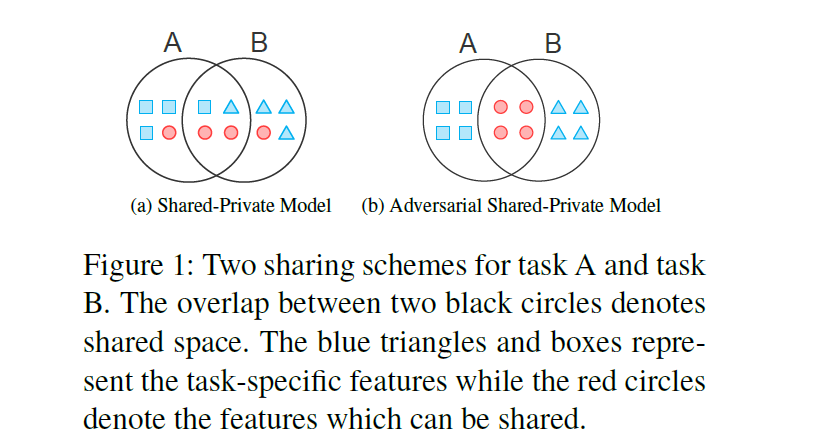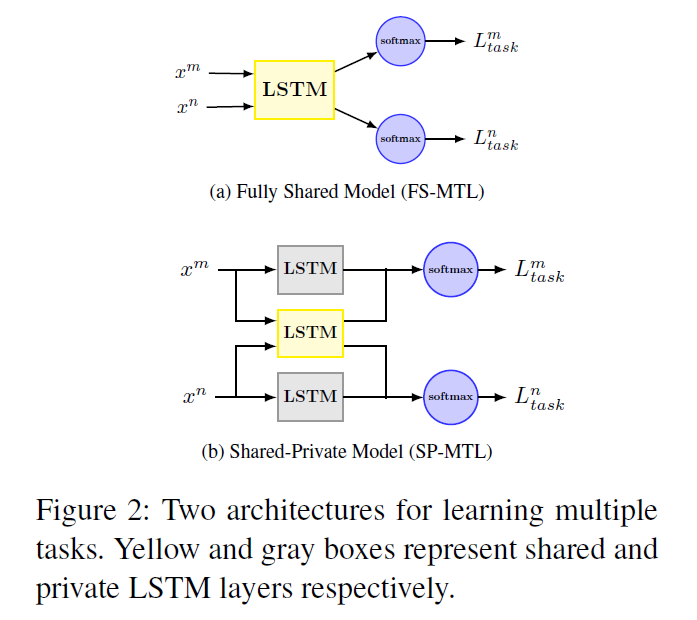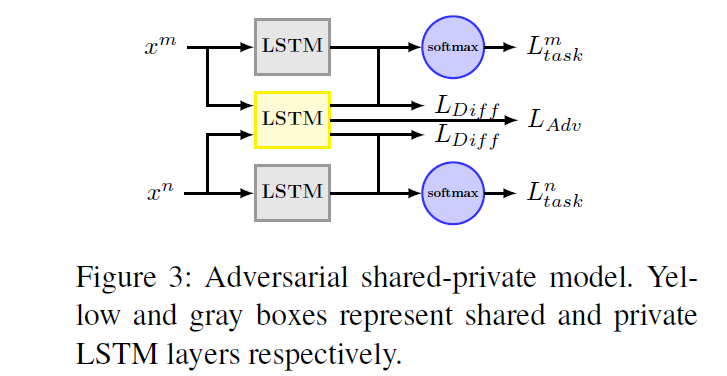9.Adversarial Multi-task Learning for Text Classification (2017)
목차
- Abstract
- Introduction
- Recurrent Models for Text Classification
- LSTM
- Text Classification with LSTM
- Multi-task Learning for Text Classification
- Two Sharing Schemes for Sentence Modeling
- Task-Specific Output Layer
- Incorporating Adversarial Training
- Adversarial Network
- Task Adversarial Loss for MTL
- Orthogonality Constraints
- Put it all together
Abstract
Multi-task learning : focus on learning the shared layers to extract common and task-invariant features
BUT…prone to be contaminated by task-specific features..
This paper proposes an ADVERSARIAL multi-task learning framework!
- alleviate the “shared” and “private” latent feature spaces from interfering with each other
1. Introduction
Multi-task learning
- efficient approach to improve the performance of “single task” with the help of “other tasks”
- however, modern methods attempts to divide the features of different tasks into private & shared, MERELY based on whether the params of some components should be shared!

(figure 1-a) Shared-Private model
-
2 feature spaces for any task
-
(space 1) to store task-dependent features
-
(space 2) to capture shared features
-
-
limitation :
-
shared feature space could contain some unnecessary task-specific fatures
-
sharable features could also be mixed in private space
-
To address this problem, propose ADVERSARIAL multi-task framework
-
shared & private feature spaces are inherently disjoint by introducing “orthogonality constraints”
-
Introduce 2 strategies
- 1) adversarial training : to ensure that the shared feature space simply contains common & task-invariation information
- 2) orthogonality constraints : to eliminate redundant features from the private & shared space
Contribution
- 1) divides task-specific & shared space in a more precise way
- 2) extend binary adversarial training to multi-class
- 3) condense the shared knowledge among multiple tasks
2. Recurrent Models for Text Classification
2-1. LSTM
\(\begin{aligned} \left[\begin{array}{c} \tilde{\mathbf{c}}_{t} \\ \mathbf{o}_{t} \\ \mathbf{i}_{t} \\ \mathbf{f}_{t} \end{array}\right] &=\left[\begin{array}{c} \tanh \\ \sigma \\ \sigma \\ \sigma \end{array}\right]\left(\mathbf{W}_{p}\left[\begin{array}{c} \mathbf{x}_{t} \\ \mathbf{h}_{t-1} \end{array}\right]+\mathbf{b}_{p}\right), \\ \mathbf{c}_{t} &=\tilde{\mathbf{c}}_{t} \odot \mathbf{i}_{t}+\mathbf{c}_{t-1} \odot \mathbf{f}_{t} \\ \mathbf{h}_{t} &=\mathbf{o}_{t} \odot \tanh \left(\mathbf{c}_{t}\right) \end{aligned}\).
- \(\mathbf{x}_{t} \in \mathbb{R}^{e}\) : input at the current time step
- \(\mathbf{W}_{p} \in \mathbb{R}^{4 d \times(d+e)}\) : parameters
Update of each LSTM unit : \(\mathbf{h}_{t}=\mathbf{L S T M}\left(\mathbf{h}_{t-1}, \mathbf{x}_{t}, \theta_{p}\right)\)
2-2. Text Classification with LSTM
\(\hat{\mathbf{y}}=\operatorname{softmax}\left(\mathbf{W} \mathbf{h}_{T}+\mathbf{b}\right)\).
\(L(\hat{y}, y)=-\sum_{i=1}^{N} \sum_{j=1}^{C} y_{i}^{j} \log \left(\hat{y}_{i}^{j}\right)\).
3. Multi-task Learning for Text Classification
goal of multi-task learning : utilizes the correlation among these tasks!
\(D_k\) : dataset with \(N_k\) samples for task \(k\)
\(D_{k}=\left\{\left(x_{i}^{k}, y_{i}^{k}\right)\right\}_{i=1}^{N_{k}}\).
- \(x_{i}^{k}\): sentence
- \(y_{i}^{k}\) : label
3-1. Two Sharing Schemes for Sentence Modeling
Introduce 2 sharing schemes
- 1) fully-shared scheme
- 2) shared-private scheme

1) Fully-Shared Model (FS-MTL)
-
use single shared LSTM layer to extract features for all the tasks
-
ignores the fact that some features are task dependent
2) Shared-Private Model (SP-MTL)
-
introduce 2 feature spaces for each task
- 1) task-dependent features
- 2) task-invariant features
-
\(\mathrm{s}_{t}^{k}\): shared representation
-
\(\mathbf{h}_{t}^{k}\): task-specific representation
\(\begin{aligned} \mathbf{s}_{t}^{k} &=\mathbf{L} \mathbf{S} \mathbf{T} \mathbf{M}\left(x_{t}, \mathbf{s}_{t-1}^{k}, \theta_{s}\right) \\ \mathbf{h}_{t}^{k} &=\mathbf{L} \mathbf{S} \mathbf{T} \mathbf{M}\left(x_{t}, \mathbf{h}_{t-1}^{m}, \theta_{k}\right) \end{aligned}\).
3-2. Task-Specific Output Layer
parameters of network are trained to minimize CE loss!
\(L_{\text {Task }}=\sum_{k=1}^{K} \alpha_{k} L\left(\hat{y}^{(k)}, y^{(k)}\right)\).
- \(\alpha_k\) : weights for each tasks \(k\)
4. Incorporating Adversarial Training
No guarantee that sharable features cannot exist in private feature space
\(\rightarrow\) solution : ADVERSARIAL training into multi-task framework!

4-1. Adversarial Network
learn a generative distribution \(p_G(x)\) that matches real data distn \(P_{\text{data}}(x)\)
\(\begin{aligned} \phi &=\min _{G} \max _{D}\left(E_{x \sim P_{\text {data }}}[\log D(x)]\right. \left.+E_{z \sim p(z)}[\log (1-D(G(z)))]\right) \end{aligned}\).
4-2. Task Adversarial Loss for MTL
Shared recurrent neural layer is working adversarially towards a learnable multi-layer perceptrion,
preventing it from making an accurate prediction about the types of tasks.
(1) Task Discriminator
- estimate what kinds of tasks the encoded sentence comes from
- \(D\left(\mathbf{s}_{T}^{k}, \theta_{D}\right)=\operatorname{softmax}\left(\mathbf{b}+\mathbf{U s}_{T}^{k}\right)\).
(2) Adversarial Loss
-
add extra task adversarial loss \(L_{A d v}\).
( to prevent task-specific feature from creeping into shared space )
-
\(L_{A d v}=\min _{\theta_{s}}\left(\lambda \max _{\theta_{D}}\left(\sum_{k=1}^{K} \sum_{i=1}^{N_{k}} d_{i}^{k} \log \left[D\left(E\left(\mathrm{x}^{k}\right)\right)\right]\right)\right)\).
(3) Semi-supervised Learning Multi-task Learning
- \(L_{A d v}\) only requires input \(x\)
- not only utilize the data from related tasks, but can employ abundant unlabeled corpora
4-3. Orthogonality Constraints
-
drawback : task-invariant features can appear both in shared & private space
-
1) penalize redundant latent representations
2) encourages shared & private extractors to encode different aspects of the inputs!
-
\(L_{\mathrm{diff}}=\sum_{k=1}^{K} \mid \mid \mathbf{S}^{k^{\top}} \mathbf{H}^{k} \mid \mid _{F}^{2}\).
- \(\mid \mid \cdot \mid \mid _{F}^{2}\) : squared Frobenius norm
- \(\mathbf{S}^{k}\) : whose rows are the output of shared extractor \(E_{s}\left(, ; \theta_{s}\right)\)
- \(\mathbf{H}^{k}\): whose rows are the output of task-specific extractor \(E_{k}\left(; ; \theta_{k}\right)\)
4-4. Put it all together
\(L=L_{\text {Task }}+\lambda L_{\text {Adv }}+\gamma L_{\text {Diff }}\).
